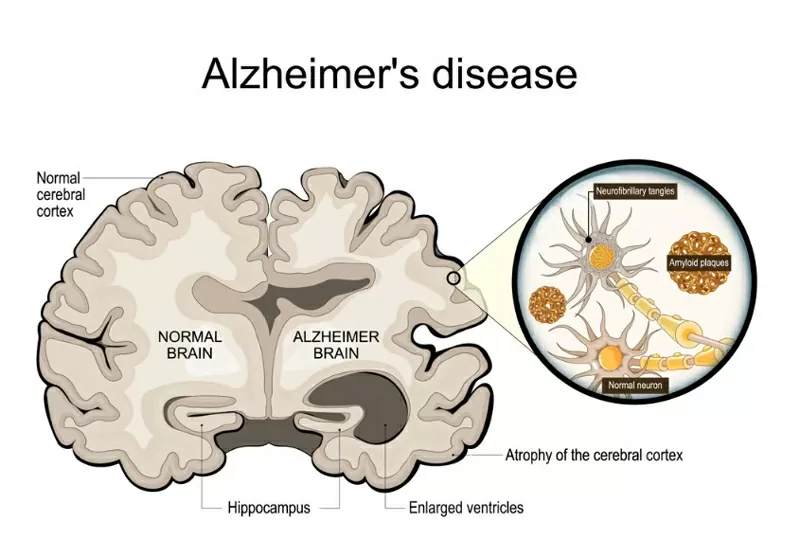More than a century after German neurologist Alois Alzheimer discovered abnormal clumps of protein called amyloid in the brain of a deceased patient in 1906, the amyloid hypothesis has dominated our thinking about Alzheimer's disease.
These are now known as amyloid plaques, along with neurofibrillary tangles or “tau” tangles — accumulations of tau protein inside nerve cells — that are key features of Alzheimer's disease.
Their presence can set off a chain reaction that leads to the symptoms we associate with dementia.
Some people have the amyloid plaques and tau tangles associated with Alzheimer's but never develop dementia. Illustration: Shutterstock |
Some people have the amyloid plaques and tau tangles associated with Alzheimer's but never develop dementia. Illustration: Shutterstock
But having amyloid deposits in the brain does not always lead to dementia. Some people develop amyloid plaques and tau tangles but never develop the characteristic symptoms of dementia.
This is often explained by the patient's cognitive reserve – the brain's ability to withstand damage, which we can build up by keeping our brains active and through continued social interaction as we age.
A 2006 paper from the University of Minnesota in the United States, published in the journal Nature and later becoming one of the most cited papers in the Alzheimer's field, appeared to prove that amyloid itself is the cause of memory loss and cognitive decline associated with dementia.
However, in 2022, the main images used in that article were said to have been edited to better match the scientists ' conclusions and the work was retracted.
The case prompted American investigative journalist and author Charles Piller to cast doubt on the amyloid hypothesis in his recent book, Doctored: Fraud, Arrogance, and Tragedy in the Quest to Cure Alzheimer's.
“At first, I was stunned that an experiment that was so important in supporting the amyloid hypothesis was based on such clearly falsified images and behavior,” Piller said, noting that in all areas of life, a minority of people will cut corners or even cheat for personal gain.
“Although image editing in Alzheimer's research represents only a small portion of the overall research effort, it can still have serious consequences in distorting ideas and slowing progress.”
That doesn't mean amyloids have nothing to do with Alzheimer's, but there are other mechanisms at play that may not have received enough attention, Piller says.
“There are many ideas about the causes or effects of Alzheimer’s disease beyond amyloid protein,” says Piller . For one thing, there’s a lot of exciting research underway on the possible benefits of a class of drugs called GLP-1 agonists, including ongoing clinical trials that could yield important results. GLP-1 agonists include semaglutide—the main ingredient in the weight-loss drugs Ozempic and Wegovy. They mimic the action of the hormone GLP-1, which helps regulate insulin and blood sugar levels in the body. They can also cross the blood-brain barrier and may help clear toxic proteins. GLP-1 drugs also have anti-inflammatory and neuroprotective properties and the ability to balance insulin in the body—which is important: people with type 2 diabetes have a much higher risk of developing Alzheimer’s—more than 50 percent—than people without diabetes.
Alzheimer's researchers increasingly point to insulin resistance in the brain as a risk factor for the disease, which explains why it's sometimes called type 3 diabetes.
Professor Daniel Drucker of the University of Toronto in Ontario, Canada, has conducted important research on GLP-1 drugs and their effects on human organs including the brain. He said that GLP-1 drugs “improve blood flow, reduce brain inflammation, improve brain cell health, strengthen the blood-brain barrier that protects the brain, and also [increase] the connectivity and communication between brain cells.”
There is growing evidence that infections that can lie dormant in the human body for years, such as herpes simplex virus (HSV) type 1, may be an important factor in the later development of Alzheimer's disease, the professor said.
There are eight types of herpes viruses that infect humans, all of which can remain latent in the body for life after a person is infected. HSV-1 is the type most strongly linked to Alzheimer's disease.
“The idea of an infectious agent – HSV-1 – in the so-called sterile brain is astonishing, and the possibility that it plays a major role in Alzheimer’s disease is even more astonishing,” says Ruth Itzhaki, emeritus professor of neurology at the University of Manchester in the UK.
However, she also said there is evidence that HSV-1 is present at high levels in the brains of older people and how it makes them more susceptible to dementia. She said it probably lies dormant in the brain most of the time. “But [it] can be reactivated through brain inflammation, which can be caused by things like stress, UV light, fever, brain trauma, inflammation”—the same stressors that can trigger a herpes outbreak, caused by the same virus. The virus then multiplies and spreads, causing damage and inflammation, creating a vicious cycle.
Scientists are still trying to understand what causes dementia. In the absence of a cure, we need to understand the risk factors for the disease and do our best to control or reduce them.

























































![[Maritime News] Container shipping faces overcapacity that will last until 2028](https://vphoto.vietnam.vn/thumb/402x226/vietnam/resource/IMAGE/2025/7/30/6d35cbc6b0f643fd97f8aa2e9bc87aea)













































Comment (0)